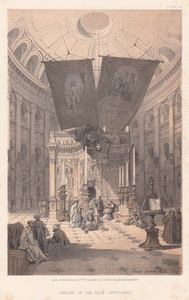| Method | Lithograph with tint stone |
| Artist | after David Roberts |
| Published | London, Published August 1st. 1855, by Day & Son, 17, Gate Street, Lincoln's Inn Fields |
| Dimensions | Image 211 x 140 mm, Sheet 285 x 202 mm |
| Notes |
Plate 14 from Volume 1 of the small format reprint of Roberts' The Holy Land, Syria, Idumea, Arabia, Egypt & Nubia. A view of the interior of the Church of the Holy Sepulchre, within the Christian Quarter of the Old City in Jerusalem. The Church, one of the most holy sites of Christendom, purports to enclose the sites of Christ's crucifixion, burial, and resurrection. Shared equally between the Byzantine, Latin, Alexandrian, Armenian, and East Syrian Rite, the current Church is the result of almost two millennia of constant use and enlargement. The original church, built by St Helena, mother of Constantine, was constructed on the site following the removal of the pagan Temple of Venus built there by order of the Emperor Hadrian during his enlargement of Roman Jerusalem, Aelia Capitolina. The city's tumultuous history has seen the church fall under the influence of many different religious orders. Since 1767, the Church has been divided evenly between the Roman Catholic and Oriental Orthodox churches. Roberts' view shows the interior of the Church's rotunda. At centre is the Aedicule, the chapel which houses the Angel's Stone and the tomb of Christ. The Aedicule is ornately decorated, and groups of Christian pilgrims of various denominations gather in front of the chapel entry. The entryway is lined with tall candles, and two banners of Christ pantokrator hang above. David Roberts RA (24th October 1796 – 25th November 1864) was a Scottish painter. He is especially known for a prolific series of detailed prints of Egypt and the Near East produced during the 1840s from sketches made during long tours of the region (1838-1840). This work, and his large oil paintings of similar subjects, made him a prominent Orientalist painter. He was elected as a Royal Academician in 1841. The firm of Day & Haghe was one of the most prominent lithographic companies of the nineteenth-century. They were also amongst the foremost pioneers in the evolution of chromolithography. The firm was established in 1823 by William Day, but did not trade under the moniker of Day & Haghe until the arrival of Louis Haghe in 1831. In 1838, Day & Haghe were appointed as Lithographers to the Queen. However, and perhaps owing to the fact that there was never a formal partnership between the two, Haghe left the firm in the 1850's to devote himself to watercolour painting. The firm continued as Day & Son under the guidance of William Day the younger (1823 - 1906) but, as a result of a scandal involving Lajos Kossuth, was forced into liquidation in 1867. Vincent Brookes bought the company in the same year, and would produce the caricatures for Gibson Bowles' Vanity Fair magazine, as well as the illustrations for Cassells's Poultry Book, amongst other commissions. Condition: Foxing to margins, not affecting image. |
| Framing | unmounted |
| Price | £30.00 |
| Stock ID | 39328 |

